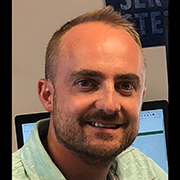A .gov website belongs to an official government organization in the United States.
A lock () or https:// means you've safely connected to the .gov website. Share sensitive information only on official, secure websites.

Energy originating from the sun and reaching Earth's surface, known as the surface solar irradiance (SSI), ultimately drives virtually all Earth-atmosphere processes. The SSI is strongly modulated by clouds, including shallow cumulus clouds that are encountered frequently across the globe. The detailed 3D spatial structure of shallow cumulus clouds, their rapid evolution, and aerosol embedded within the cloud field, all lead to complex variability in SSI that has proven challenging to understand and predict. In this talk, I will show how this SSI variability is captured concisely by the bi-modal shape of the SSI probability density function (PDF), which is robustly observed but only reproduced in simulations with 3D radiative transfer. I will demonstrate that, despite common beliefs, 3D radiative effects do not disappear with space-time averaging. To address these issues, machine-learning algorithms are explored to construct a mapping between cloud and aerosol properties, derived from large eddy simulation, and the corresponding SSI PDF, derived from 3D radiative transfer. I will show the drastic improvements in prediction of SSI relative to traditional 1D radiative transfer, while bypassing the computational expense of 3D radiative transfer. I will also share an approach that quantifies the relative importance of each predictor, revealing the inordinately large importance of aerosol between clouds. The new findings have important implications for solar renewable energy assessment, highlight the significance of the absence of 3D radiative effects in weather and climate modeling, and provide a route forward for efficient parameterization of 3D radiative effects at the surface.
Dr. Jake Gristey is a Research Scientist at CIRES and NOAA CSL, and is also affiliated with the Laboratory for Atmospheric and Space Physics (LASP) at the University of Colorado. He received his Master's degree in 2014 and PhD degree in 2018 from the Department of Meteorology at the University of Reading in the UK, including a year of study at the University of Oklahoma and a research placement at NASA's Jet Propulsion Laboratory. Dr. Gristey splits his time between two research foci. First, he works as part of the NOAA Atmospheric Science for Renewable Energy program to advance understanding of solar energy variability below shallow cumulus clouds (the topic of this seminar). Second, he leads the development of irradiance retrieval algorithms for the upcoming Libera satellite mission, due to launch toward the end of the decade.
ALL Seminar attendees agree not to cite, quote, copy, or distribute material presented without the explicit written consent of the seminar presenter. Any opinions expressed in this seminar are those of the speaker alone and do not necessarily reflect the opinions of NOAA or CSL.